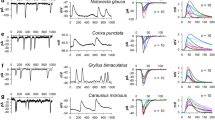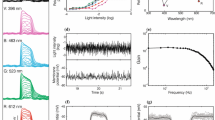Abstract
Filtering properties of the membrane form an integral part of the mechanisms producing the light-induced electrical signal in insect photoreceptors. Insect photoreceptors vary in response speed between different species, but recently it has also been shown that different spectral photoreceptor classes within a species possess diverse response characteristics. However, it has not been quantified what roles phototransduction and membrane properties play in such diversity. Here, we use electrophysiological methods in combination with system analysis to study whether the membrane properties could create the variation of the response speed found in the bumblebee (Bombus terrestris) photoreceptors. We recorded intracellular responses from each photoreceptor class to white noise-modulated current stimuli and defined their input resistance and linear filtering properties. We found that green sensitive cells exhibit smaller input resistance and membrane impedance than other cell classes. Since green sensitive cells are the fastest photoreceptor class in the bumblebee retina, our results suggest that the membrane filtering properties are correlated with the speed of light responses across the spectral classes. In general, our results provide a compelling example of filtering at the sensory cell level where the biophysical properties of the membrane are matched to the performance requirements set by visual ecology.






Similar content being viewed by others
Abbreviations
- 3 dB:
-
3 Decibels
- C m :
-
Membrane capacitance
- DA:
-
Dark-adapted
- ∆t :
-
Response half-width
- I–V curve:
-
Current–voltage relation
- LA:
-
Light-adapted
- R m :
-
Membrane resistance
- σ:
-
Skewness of the log-normal fit of the impulse response
- τm :
-
Membrane time-constant
- t p :
-
Time-to-peak of the log-normal fit of the impulse response
- WN:
-
“White noise”, pseudorandomly modulated time-series that has a constant power spectrum within a defined bandwidth
References
Anderson JC, Laughlin SB (2000) Photoreceptor performance and the co-ordination of achromatic and chromatic inputs in the fly visual system. Vision Res 40:13–31
Brennecke R, Lindemann B (1974) Theory of a membrane-voltage clamp with discontinuous feedback through a pulsed current clamp. Rev Sci Instrum 45:184–188
Briscoe AD, Chittka L (2001) The evolution of color vision in insects. Annu Rev Entomol 46:471–510
Cameron SA, Hines HM, Williams PH (2007) A comprehensive phylogeny of the bumble bees (Bombus). Biol J Linn Soc 91:161–188
Chittka L, Beier W, Hertel H, Steinmann E, Menzel R (1992) Opponent colour coding is a universal strategy to evaluate the photoreceptor inputs in Hymenoptera. J Comp Physiol A 170:545–563
Conway BR (2002) Neural mechanisms of colour vision. Kluwer Academic Publishers, Norwell
Finkel AS, Redman SJ (1984) Theory and operation of a single microelectrode voltage clamp. J Neurosci Methods 11:101–127
Frederiksen R, Wcislo WT, Warrant EJ (2008) Visual reliability and information rate in the retina of a nocturnal bee. Curr Biol 18:349–353
Gentet LJ, Stuart GJ, Clements JD (2000) Direct measurement of specific membrane capacitance in neurons. Biophys J 79:314–320
Giger AD, Srinivasan MV (1996) Pattern recognition in honeybees: chromatic properties of orientation analysis. J Comp Physiol A 178:763–769
Hardie RC (1979) Electrophysiological analysis of fly retina. I: comparative properties of R1–6 and R 7 and 8. J Comp Physiol A 129:19–33
Heimonen K, Salmela I, Kontiokari P, Weckström M (2006) Large functional variability in cockroach photoreceptors: optimization to low light levels. J Neurosci 26:13454–13462
Heimonen K, Immonen E-V, Frolov RV, Salmela I, Juusola M, Vähäsöyrinki M, Weckström M (2012) Signal coding in cockroach photoreceptors is tuned to dim environments. J Neurophysiol 108:2641–2652
Heisenberg M, Buchner E (1977) The role of retinula cell types in visual behavior of Drosophila melanogaster. J Comp Physiol A 117:127–162
Howard J, Dubs A, Payne R (1984) The dynamics of phototransduction in insects: a comparative study. J Comp Physiol A 154:707–718
Juusola M, Weckström M (1993) Band-pass filtering by voltage-dependent membrane in an insect photoreceptor. Neurosci Lett 154:84–88
Juusola M, Kouvalainen E, Järvilehto M, Weckström M (1994) Contrast gain, signal-to-noise ratio, and linearity in light-adapted blowfly photoreceptors. J Gen Physiol 104:593–621
Kaiser W (1968) Zur Frage des Unterscheidungsvermögens für Spektralfarben: eine Untersuchung der Optomotorik der königlichen Glanzfliege Phormia regina Meig. Z Vergl Physiol 61:71–102
Kaiser W (1974) The spectral sensitivity of the honeybee’s optomotor walking response. J Comp Physiol 90:405–408
Kaiser W, Liske E (1974) Die optomotorischen Reaktionen von fixiert fliegenden Bienen bei Reizung mit Spektrallichtern. J Comp Physiol 89:391–408
Kelber A (2006) Invertebrate colour vision. In: Warrant E, Nilsson D-E (eds) Invertebrate vision. Cambridge University Press, Cambridge, pp 250–290
Laughlin SB, Weckström M (1993) Fast and slow photoreceptors: a comparative study of the functional diversity of coding and conductances in the diptera. J Comp Physiol A 172:593–609
Laughlin SB, de Ruyter van Steveninck RR, Anderson JC (1998) The metabolic cost of neural information. Nat Neurosci 1:36–41
Lehrer M, Srinivasan MV, Zhang SW, Horridge GA (1988) Motion cues provide the bee’s visual world with a third dimension. Nature 332:356–357
Macuda T, Gegear RJ, Laverty TM, Timney B (2001) Behavioural assessment of visual acuity in bumblebees (Bombus impatiens). J Exp Biol 204:559–564
Marmarelis PZ, Marmarelis VZ (1978) Analysis of physiological systems: the white noise approach. Plenum, New York
Niven JE, Laughlin SB (2008) Energy limitation as a selective pressure on the evolution of sensory systems. J Exp Biol 211:1792–1804
Niven JE, Vähäsöyrinki M, Kauranen M, Hardie RC, Juusola M, Weckström M (2003) The contribution of Shaker K+ channels to the information capacity of Drosophila photoreceptors. Nature 421:630–634
Niven JE, Vähäsöyrinki M, Juusola M, French AS (2004) Interactions between light-induced currents, voltage-gated currents, and input signal properties in Drosophila photoreceptors. J Neurophysiol 91:2696–2706
Niven JE, Anderson JC, Laughlin SB (2007) Fly photoreceptors demonstrate energy-information trade-offs in neural coding. PLoS Biol 5:e116
Paulk AC, Gronenberg W (2008) Higher order visual input to the mushroom bodies in the bee, Bombus impatiens. Arthropod Struct Dev 37:443–458
Paulk AC, Phillips-Portillo J, Dacks AM, Fellous J-M, Gronenberg W (2008) The processing of color, motion, and stimulus are anatomically segregated in the bumblebee brain. J Neurosci 28:6319–6332
Paulk AC, Dacks AM, Gronenberg W (2009a) Color processing in the medulla of the bumblebee (Apidae: Bombus impatiens). J Comp Neurol 513:441–456
Paulk AC, Dacks AM, Philips-Portillo J, Fellous JM, Gronenberg W (2009b) Visual processing in the central bee brain. J Neurosci 29:9987–9999
Peitsch D, Fietz A, Hertel H, de Souza J, Ventura DF, Menzel R (1992) The spectral input systems of hymenopteran insects and their receptor-based colour vision. J Comp Physiol A 170:23–40
Salmela I, Immonen EV, Frolov R, Krause S, Krause Y, Vähäsöyrinki M, Weckström M (2012) Cellular elements for seeing in the dark: voltage-dependent conductances in cockroach photoreceptors. BMC Neurosci 13:93
Skorupski P, Chittka L (2010) Differences in photoreceptor processing speed for chromatic and achromatic vision in the bumblebee, Bombus terrestris. J Neurosci 30:3896–3903
Skorupski P, Chittka L (2011) Photoreceptor processing speed and input resistance changes during light adaptation correlate with spectral class in the bumblebee, Bombus impatiens. PLoS One 6:e25989
Skorupski P, Döring TF, Chittka L (2007) Photoreceptor spectral sensitivity in island and mainland populations of the bumblebee, Bombus terrestris. J Comp Physiol A 193:485–494
Spaethe J, Chittka L (2003) Interindividual variation of eye optics and single object resolution in bumblebees. J Exp Biol 206:3447–3453
Spaethe J, Tautz J, Chittka L (2001) Visual constraints in foraging bumblebees: flower size and color affect search time and flight behavior. Proc Natl Acad Sci USA 98:3898–3903
Spekreijse H, Oostings H (1970) Linearizing: a method for analysing and synthesizing non-linear systems. Kybernetik 7:22–30
Srinivasan MV, Lehrer M (1984) Temporal acuity of honeybee vision: behavioural studies using moving stimuli. J Comp Physiol A 155:297–312
Srinivasan M, Lehrer M (1985) Temporal resolution of colour vision in the honeybee. J Comp Physiol A 157:579–586
Srinivasan MV, Lehrer M (1987) Spatial acuity of honeybee vision and its spectral properties. J Comp Physiol A 162:159–172
Vähäsöyrinki M, Niven JE, Hardie RC, Weckström M, Juusola M (2006) Robustness of neural coding in Drosophila photoreceptors in the absence of slow delayed rectifier K+ channels. J Neurosci 26:2652–2660
Vorobyev M, Brandt R, Peitsch D, Laughlin SB, Menzel R (2001) Colour thresholds and receptor noise: behaviour and physiology compared. Vision Res 41:639–653
Wardill TJ, List O, Li X, Dongre S, McCulloch M, Ting CY, O’Kane CJ, Tang S, Lee CH, Hardie RC (2012) Multiple spectral inputs improve motion discrimination in the Drosophila visual system. Science 336:925–931
Weckström M, Laughlin SB (1995) Visual ecology and voltage-gated ion channels in insect photoreceptors. Trends Neurosci 18:17–21
Weckström M, Hardie RC, Laughlin SB (1991) Voltage-activated potassium channels in blowfly photoreceptors and their role in light adaptation. J Physiol 440:635–637
Weckström M, Kouvalainen E, Juusola M (1992) Measurement of cell impedance in frequency domain using discontinuous current clamp and white-noise-modulated current injection. Pflügers Arch 421:469–472
Yamaguchi S, Wolf R, Desplan C, Heisenberg M (2008) Motion vision is independent of color in Drosophila. Proc Natl Acad Sci USA 105:4910–4915
Author information
Authors and Affiliations
Corresponding author
Rights and permissions
About this article
Cite this article
Vähäkainu, A., Vähäsöyrinki, M. & Weckström, M. Membrane filtering properties of the bumblebee (Bombus terrestris) photoreceptors across three spectral classes. J Comp Physiol A 199, 629–639 (2013). https://doi.org/10.1007/s00359-013-0814-x
Received:
Revised:
Accepted:
Published:
Issue Date:
DOI: https://doi.org/10.1007/s00359-013-0814-x




